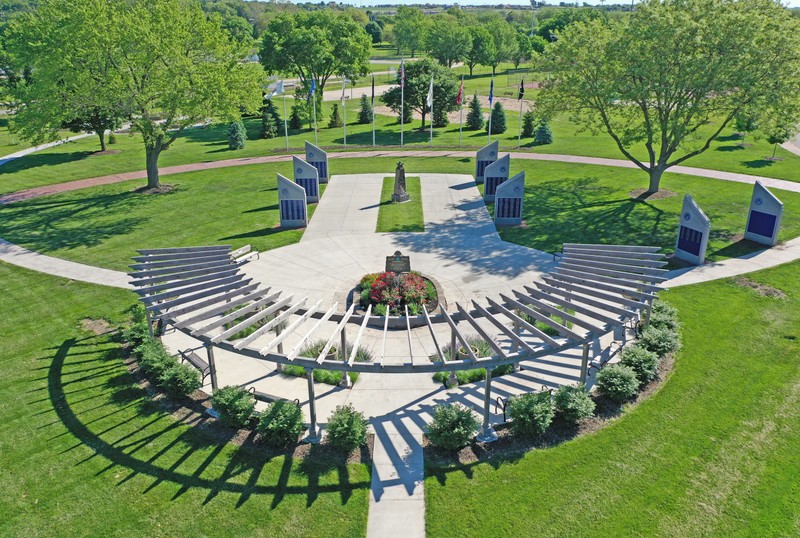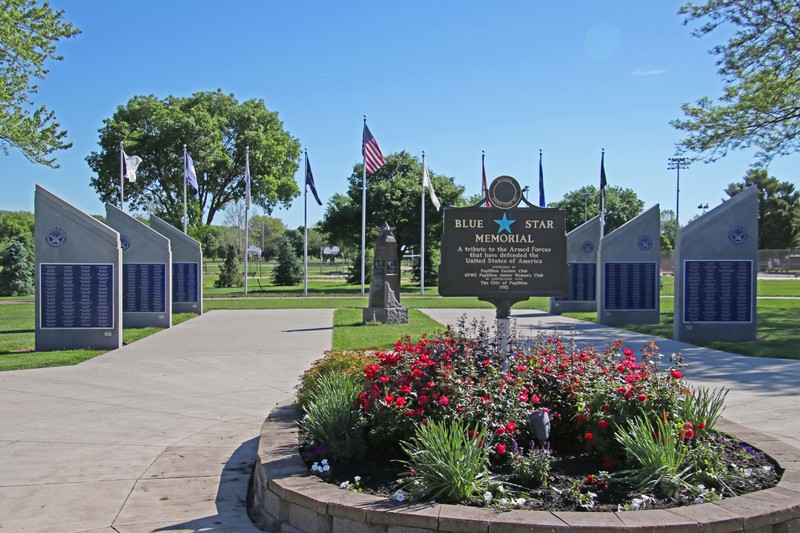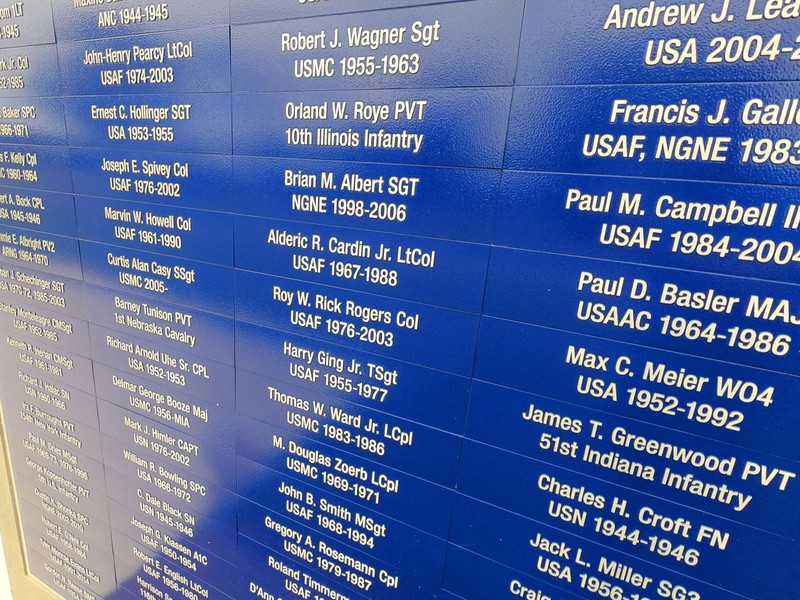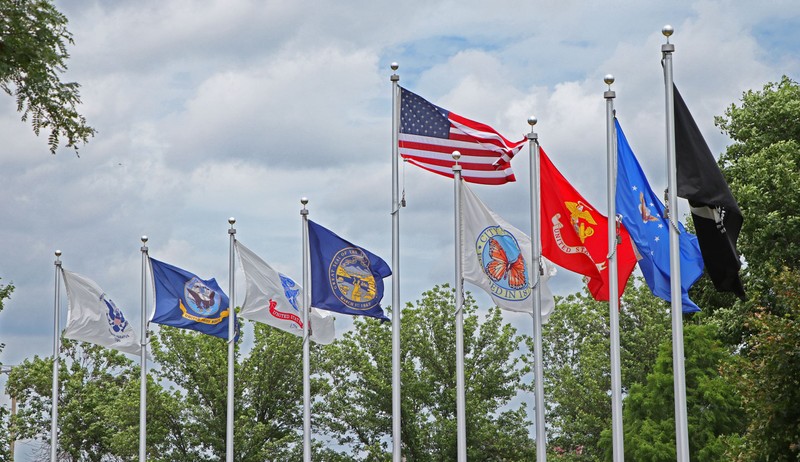Veterans Park
Introduction
Text-to-speech Audio
Veterans Park is, above everything else, a community project. From its humble beginnings as an empty plot of land to its current status as a location of beauty and solemnity, Veterans Park has been developed, improved, and maintained by the various community organizations of Papillion. The park has progressed and found consistent support despite America’s ambivalent feelings towards military service; in the face of the complex and divisive politics of war, the city of Papillion has emphasized respect and reflection in the parks design. In doing so, it has paid homage to America’s veterans and demonstrated the community spirit and cooperation of the residents of Papillion, Nebraska.
Images
Ariel view of Veterans Park

Ground view of the park

Close up of an honor wall

Nine of the park's flags.

Backstory and Context
Text-to-speech Audio
The story of Veterans Park begins in the same location, but under a different name: Triangle Park. Before 2010, Triangle Park was a bare plot of park land. It had been previously populated by a single old farmhouse, but the house was torn down. This left the park bare, its only noteworthy feature being its namesake triangle shape. Triangle Park’s emptiness ended in 2010 when a local community club, the Papillion Garden Club, decorated it with a single flower planter. In 2011, the park was further enhanced by the addition of a flagpole contributed by another local organization: the Papillion Junior Woman’s Club.[1]
Connie Leversee, one of the Garden Club’s founders, was responsible for the park’s first major addition. While travelling through the American South, Leversee first viewed a Blue Star Memorial. Blue Star Memorials are special statues designed to replicate the blue stars hung by families of deployed youth during World War II. These memorial markers are sold by the National Garden Club. The Papillion Garden Club, convinced by Leversee of the Star’s merits and aided by the Junior Woman’s club, endeavored to make Papillion the site of a Blue Star Memorial Marker. Using money earned by their craft fair fundraisers, the Garden club purchased a memorial in 2012. They worked with the city to choose Triangle Park as the memorial’s home. It was the addition of the Blue Star Memorial Marker that initiated the park’s transformation from a sparsely decorated plot of land to the spectacular monument that now stands.[2]
Papillion City Councilman Steve Engberg was said to have been walking through the city with his young grandson when the Blue Star caught his eye. He immediately saw the potential for a new park that would be centered around the Memorial. Enberg reportedly sketched his vision out on a napkin and managed to convince other local officials of its merit. Out of his many proposed changes, the most immediate was to the park's name. Working with fellow councilman Jason Gaines, Enberg issued a proposal to change the name from Triangle Park. The proposal was unanimously accepted on September 17th, 2013, and Veterans Park was born.[3]
Veterans Park's new name was just the beginning. Engberg sought to use landscaping to distinguish the park from its surroundings. He and Gowan also moved to install an irrigation system and sidewalks to open the area for more veteran commemorations. Soon enough, Papillion's many community groups began to offer their support in the new park’s development. Papillion’s branch of the veteran’s organization American Legion, American Legion Post 32, worked alongside another local organization, the Papillion Community Foundation, to raise $13,000 for the park’s improvement. The funds were used to replace the park’s one flagpole with nine: one for America, one for each branch of the military, one for Nebraska, one for prisoners of war, and one for those who went missing in action.[4]
Papillion’s community then rallied to its next great project: the honor walls. The honor walls, first unveiled in 2015, are monuments covered with the name, military branch, birth date, and death date of Sarpy County veterans. The honor walls, by name and design, are clearly reminiscent of Maya Lin’s Vietnam War memorial monument, known throughout America as “The Wall”. The Wall is the most famous Vietnam memorial in the country, and its design reflects the controversy that surrounded the war: it is a union of two long black walls filled with the names of the American soldiers who died in the war, and nothing more. This simplicity was expected of the monument; the criteria listed for the memorial’s design competition specifically emphasized neutrality and demanded that designs make no political commentary on the war. America is again facing indecision on how it views military service, and the honor walls of Veterans Park echo the neutrality and solemn respect that have made The Wall an impactful memorial.[5]
Each wall in Veterans Park holds a maximum of 68 names on two sides, for a total of 136 names per wall. Slots on the wall were available to citizens for the price of $200. The creation of the wall program was funded by an interorganizational cooperation that included the City of Papillion, the Community Foundation, the Garden Club, the Junior Women’s Club, and Legion 32. The honor wall program was adopted by the Community Foundation, and the project grew after 2015 as slots continued to be purchased. Between 2015-2019, five additional honors walls were added to the park.[6]
The next major change to the park occurred in 2020. As part of Papillion’s 150th anniversary, the Community Foundation requested aid from the community to design a butterfly garden for the city. Butterfly gardens are especially important to Papillion because of the city's symbol: the monarch butterfly. As always, the community rallied in response to the Community Foundation’s request, and funding was secured through many organizations. These include the Papillion Area Lions Club, the Junior Women’s club, and the Midlands Community Foundation. During deliberations, Community Foundation organizers were reminded that Veterans Park’s early designs had left open a space for a garden, so the park was chosen as the location for Papillion’s new butterfly garden. The most recent significant changes in the park have been the addition of a memorial obelisk honoring five deceased veterans in 2021 and the acquisition of a gold star and accompanying statues in 2022. The obelisk was added by the city of Papillion, and the gold star memorial, a monument for veterans who died in combat, was sponsored by Federated Gardens of Nebraska Inc. Three statues accompany the star as well as two flags: one flag for MIAs and POWs, and another for fallen service members.[7]
In addition to the major projects mentioned above, the Papillion community has been continuously developing and maintaining the park. Benches, walking paths, signs, and trees have been steadily added to perfect the park's charm. As of November of 2022, the park has eleven flags: a space force flag, a Papillion flag, an Honor and Remember flag, and all the original nine flags (the MIA and POW flags have been combined into one). An eighth honor wall has been added, and 1034 veterans are currently honored in the park.[8]
Sources
[1] Kelsey Stewart, “New angle on park name,” Omaha World-Herald, September 25, 2015, NewsBank; “History,” Veterans Park, City of Papillion, accessed November 8, 2022, https://www.papillion.org/996/History.
[2] Vince Mancuso, “Blue Star Dawning,” Papillion Times, 2012; "About,” Papillion Garden Club, accessed November 8, 2022, https://www.papilliongardenclub.org/about.html; “Blue and Gold Star Memorials,” National Garden Clubs Official Website, National Garden Clubs, Inc, accessed November 8, 2022, https://www.gardenclub.org/blue-and-gold-star-memorials.
[3] Kelsey Stewart, “Veterans Day ceremony unveils newest project in park,” Omaha World-Herald, November 19, 2015, NewsBank; Stewart, “New angle.”
[4] Stewart, “New angle”; Kelsey Stewart, “American Legion, city working to improve Veterans Park,” Omaha World-Herald, November 12, 2014, NewsBank; “Misson & History,” Papillion American Legion Post 32, accessed November 8, 2022, https://www.americanlegionpost32.com/mission-history; Papillion, “History.”
[5] Papillion, “History”; Marling, Karal Ann, and Robert Silberman. “The Statue near the Wall: The Vietnam Veterans Memorial and the Art of Remembering.” Smithsonian Studies in American Art, vol. 1, no. 1, 1987, pp. 5–29. Accessed 13 Dec. 2022, JSTOR, http://www.jstor.org/stable/3108969.
[6] “Veterans Park,” Papillion Community Foundation, accessed November 8, 2022, https://www.papillionfoundation.org/veterans-park; Papillion, “History”; Emily Nohr, “’It’s an honoring place’ 3 years in the making, Papillion park salutes veterans," Omaha World-Herald, November 9, 2015.
[7] Karla Rupiper, “Explore Papillion | Butterfly & Pollinator Garden,” CityofPapillion, October 8, 2021, YouTube video, 7:45, https://www.youtube.com/watch?v=qqtl1oaLPIM; Papillion, “History.”
[8] Papillion, “History.”
“Gallery,” Veterans Park, City of Papillion, accessed December 13, 2022, https://www.papillion.org/1000/Gallery. Posted with permission of the City of Papillion.
Papillion, “Gallery.” Posted with permission of the City of Papillion.
Papillion, “Gallery.” Posted with permission of the City of Papillion.
Papillion, “Gallery.” Posted with permission of the City of Papillion.
